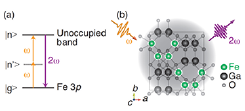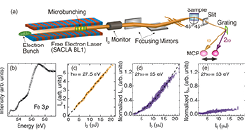Observation of Second Harmonic Generation in Soft X-Ray and Study of its Element Selectivity
I. Matsuda, Akai, Wadati, and Shin Groups
Second harmonic generation (SHG) is the well-known nonlinear optical frequency conversion and it has been a significant probe to investigate the electronic properties of matter. In the SHG process, optical fields interact with a medium of broken inversion symmetry, resulting in production of a double field frequency. Recent development of a free electron laser (FEL), the high brilliant laser in the energy range from vacuum ultraviolet to X-ray, allows to explore nonlinear optical effects in these energy ranges. All of the earlier studies on non-linear optics in those energy ranges reported experiments conducted under a transmission geometry in order to acquiring enough signals by meeting phase-matching condition. In the soft X-ray range, the reflection geometry is preferred because the light in the energy range is strongly absorbed by materials. However, in the reflection geometry, the non-linear optical experiments suffer the extremely low signals due to the absence of coherent amplification caused by the phase matching.

Fig. 1. Second harmonic generation in the GaFeO3 crystal using Fe 3p resonance. (a) Energy diagram of SHG. The notations, g, n’, and n represent the ground state, virtual state, and excited state, respectively. (b) Projection view along the c axis of the crystal structure of GaFeO3.

Fig. 2. (a) Schematic diagram of the SXFEL beamline at SACLA and the SHG measurement system. (b) Fe 3p absorption spectrum of the GaFeO3 crystal. (c) Intensity plot of the ω component of the reflected SXFEL pulses, Iω, with respect to the correspondent incident intensity, I0, at the photon energy ħω = 27.5 eV. (d) Plot of I2ω at the photon energy of 2ħω = 55 eV. (e) Plot of I2ω at the photon energy of 2ħω = 53 eV. The dashed lines shown in (c) and (d) were fitted by a power law.
Here, we demonstrate observation of SHG from a non-centrosymmetric crystal by employing the resonance effect described below, even under the reflection geometry (Fig. 1). The experiment was carried out by using a soft X-ray FEL (SXFEL) at SACLA in Harima. SHG signals were detected when the photon energy with double frequency 2ω was above the absorption edge of the sample, as shown in Fig. 2. The metal M-edge resonance inherently indicates addition of element specificity to the SHG experiment. Moreover, the reflection measurement geometry indicates that the present method can be used for various samples and experimental conditions. The optical frequency conversion with SXFEL is expected to selectively probe the electronic properties of nonlinear bulk crystals and the interfaces in heterostructures that are composed of multi-element materials.
References
- [1] Sh. Yamamoto, T. Omi, H. Akai, Y. Kubota, Y. Takahashi, Y. Suzuki, Y. Hirata, K. Yamamoto, R. Yukawa, K Horiba, H. Yumoto, T. Koyama, H. Ohashi, S. Owada, K. Tono, M. Yabashi, E. Shigemasa, S. Yamamoto, M. Kotsugi, H. Wadati, H. Kumigashira, T. Arima, S. Shin, and I. Matsuda, Phys. Rev. Lett. 120, 223902 (2018).
